
Perissodactyla is an order of ungulates. The order includes about 17 living species divided into three families: Equidae, Rhinocerotidae (rhinoceroses), and Tapiridae (tapirs). They typically have reduced the weight-bearing toes to three or one of the five original toes, though tapirs retain four toes on their front feet. The nonweight-bearing toes are either present, absent, vestigial, or positioned posteriorly. By contrast, artiodactyls bear most of their weight equally on four or two of the five toes: their third and fourth toes. Another difference between the two is that odd-toed ungulates digest plant cellulose in their intestines, rather than in one or more stomach chambers as even-toed ungulates, with the exception of Suina, do.

Ungulates are members of the diverse clade Euungulata which primarily consists of large mammals with hooves. Once part of the clade "Ungulata" along with the clade Paenungulata, "Ungulata" has since been determined to be a polyphyletic and thereby invalid clade based on molecular data. As a result, true ungulates had since been reclassified to the newer clade Euungulata in 2001 within the clade Laurasiatheria while Paenungulata has been reclassified to a distant clade Afrotheria. Living ungulates are divided into two orders: Perissodactyla including equines, rhinoceroses, and tapirs; and Artiodactyla including cattle, antelope, pigs, giraffes, camels, sheep, deer, and hippopotamuses, among others. Cetaceans such as whales, dolphins, and porpoises are also classified as artiodactyls, although they do not have hooves. Most terrestrial ungulates use the hoofed tips of their toes to support their body weight while standing or moving. Two other orders of ungulates, Notoungulata and Litopterna, both native to South America, became extinct at the end of the Pleistocene, around 12,000 years ago.
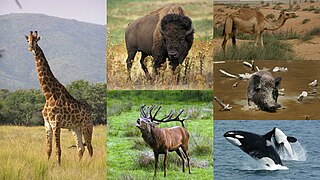
Artiodactyls are mammals belonging to the order Artiodactyla. Typically, they are ungulates which bear weight equally on two of their five toes: the third and fourth, often in the form of a hoof. The other three toes are either present, absent, vestigial, or pointing posteriorly. By contrast, most perissodactyls bear weight on an odd number of the five toes. Another difference between the two is that many artiodactyls digest plant cellulose in one or more stomach chambers rather than in their intestine as perissodactyls do. The advent of molecular biology, along with new fossil discoveries, found that cetaceans fall within this taxonomic branch, being most closely related to hippopotamuses. Some modern taxonomists thus apply the name Cetartiodactyla to this group, while others opt to include cetaceans within the existing name of Artiodactyla. Some researchers use "even-toed ungulates" to exclude cetaceans and only include terrestrial artiodactyls, making the term paraphyletic in nature.
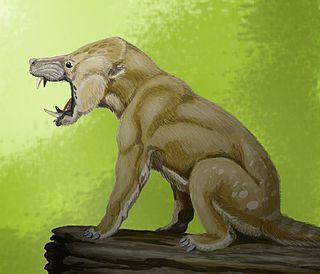
Condylarthra is an informal group – previously considered an order – of extinct placental mammals, known primarily from the Paleocene and Eocene epochs. They are considered early, primitive ungulates. It is now largely considered to be a wastebasket taxon, having served as a dumping ground for classifying ungulates which had not been clearly established as part of either Perissodactyla or Artiodactyla, being composed thus of several unrelated lineages.

Phenacodus is an extinct genus of mammals from the late Paleocene through middle Eocene, about 55 million years ago. It is one of the earliest and most primitive of the ungulates, typifying the family Phenacodontidae and the order Perissodactyla.

Dinocerata or Uintatheria, also known as uintatheres, is an extinct order of large herbivorous hoofed mammals with horns and protuberant canine teeth, known from the Paleocene and Eocene of Asia and North America. With body masses ranging up to 4,500 kilograms (9,900 lb) they represent some of the earliest known large mammals.

The Antilocapridae are a family of artiodactyls endemic to North America. Their closest extant relatives are the giraffids. Only one species, the pronghorn, is living today; all other members of the family are extinct. The living pronghorn is a small ruminant mammal resembling an antelope.

Daeodon is an extinct genus of entelodont even-toed ungulates that inhabited North America about 23 to 20 million years ago during the latest Oligocene and earliest Miocene. The type species is Daeodon shoshonensis, described by a very questionable holotype by Cope. Some authors synonymize it with Dinohyus hollandi and several other species, but due to the lack of diagnostic material, this is questionable at best.

Arctocyon is an extinct genus of ungulate mammals. Arctocyon was a "ground dwelling omnivore", that lived from 61.3-56.8 Ma. Synonyms of Arctocyon include Claenodon, and Neoclaenodon. Arctocyon was likely plantigrade, meaning that it walked with its feet flat on the ground, rather than on its toes.
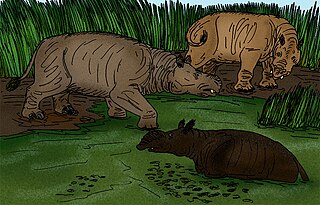
Amynodontidae is a family of extinct perissodactyls related to true rhinoceroses. They are commonly portrayed as semiaquatic hippo-like rhinos but this description only fits members of the Metamynodontini; other groups of amynodonts like the cadurcodontines had more typical ungulate proportions and convergently evolved a tapir-like proboscis.

Mesonychidae is an extinct family of small to large-sized omnivorous-carnivorous mammals. They were endemic to North America and Eurasia during the Early Paleocene to the Early Oligocene, and were the earliest group of large carnivorous mammals in Asia. They are not closely related to any living mammals. Mesonychid taxonomy has long been disputed and they have captured popular imagination as "wolves on hooves," animals that combine features of both ungulates and carnivores. Skulls and teeth have similar features to early whales, and the family was long thought to be the ancestors of cetaceans. Recent fossil discoveries have overturned this idea; the consensus is that whales are highly derived artiodactyls. Some researchers now consider the family a sister group either to whales or to artiodactyls, close relatives rather than direct ancestors. Other studies define Mesonychia as basal to all ungulates, occupying a position between Perissodactyla and Ferae. In this case, the resemblances to early whales would be due to convergent evolution among ungulate-like herbivores that developed adaptations related to hunting or eating meat.

Arctocyonidae has been defined as an extinct family of unspecialized, primitive mammals with more than 20 genera. Animals assigned to this family were most abundant during the Paleocene, but extant from the late Cretaceous to the early Eocene . Like most early mammals, their actual relationships are very difficult to resolve. No Paleocene fossil has been unambiguously assigned to any living order of placental mammals, and many genera resemble each other: generalized robust, not very agile animals with long tails and all-purpose chewing teeth, living in warm closed-canopy forests with many niches left vacant by the K-T extinction.
Pristinictis is an extinct genus of placental mammals from extinct subfamily Didymictinae within extinct family Viverravidae, that lived in North America during middle Paleocene.
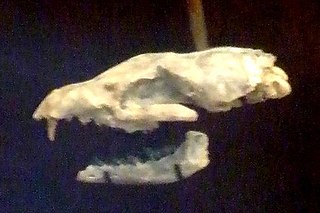
Cormocyon is an extinct genus of borophagine canid native to North America. It lived from the Oligocene to the Early Miocene, 30.8—20.6 Mya, existing for about 10.2 million years. It is regarded as a primitive, transitional member of the Borophagini tribe.
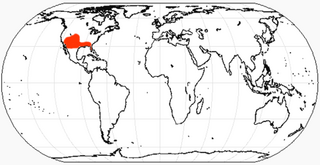
Carpocyon is an extinct genus of the Borophaginae subfamily of canids native to North America. It lived from the Middle to the Late Miocene, 13.6 to 5.3 Ma Mya, existing for approximately 16.5 million years. The four species in the genus varied in size, with the largest being about the size of a wolf; all had relatively small teeth, suggesting a diet that was more omnivorous than that of other contemporary borophagines.

Hypohippus is an extinct genus of three-toed horse, which lived 17–11 million years ago. It was the largest anchitherine equid about the size of a modern domestic horse, at 403–600 kg (888–1,323 lb) and 1.8 m (5.9 ft) long. It was a long-necked, high-shouldered browser with sub-hypsodont, lophodont (rhino-like) dentition, that fed on the tough vegetation of forest understory and shrubs. Its deep preorbital fossae and retraction of the nasal notch hint at the presence of a long, muscular and prehensile upper lip that would aid during selective browsing. Overall its ecology would have been more comparable to modern okapi than to grazing horses. Fossils of it have been found in Nebraska, Colorado, and Montana.

Phenacodontidae is an extinct family of large herbivorous mammals traditionally placed in the “wastebasket taxon” Condylarthra, which may instead represent early-stage perissodactyls. They lived in the Paleocene and Eocene epochs and their fossil remains have been found in North America and Europe.

Merycodus is an extinct genus of the artiodactyl family Antilocapridae. Fossils of this genus have been found in the Santa Fe Group of New Mexico.
Lambertocyon is a genus of ungulates from western North America. Three species are known, making their last appearance in the Late Paleocene Clarkforkian stage.
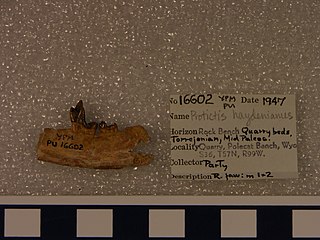
Protictis is an extinct paraphyletic genus of placental mammals from extinct subfamily Didymictinae within extinct family Viverravidae, that lived in North America from early Paleocene to middle Eocene.
















